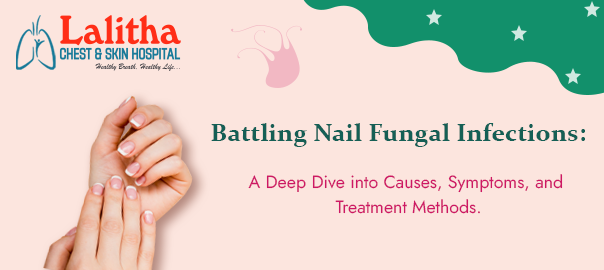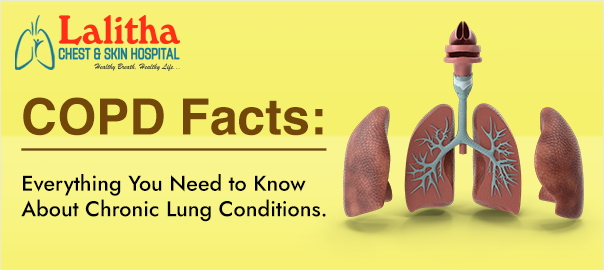Nail fungal infections, also known as onychomycosis, are common infections affecting the fingernails or toenails. These infections are caused by various types of fungi, including dermatophytes, yeasts, and non-dermatophyte molds.
“Nail fungal infections are both common and treatable. Early detection and proper treatment prevent the infection from spreading and causing further nail damage. Good nail hygiene and preventive steps are crucial in reducing the risk of infection”, explains Karimnagar’s best skin doctor & toe fungus removal specialist Dr. B. Jyothi.
Yet any infection to nails can be cause of concern for the people unaware of this condition. So with the inputs from a dermatologist in Karimnagar Dr. B. Jyothi, we today examine the causes and symptoms of nail fungal infections and provide available treatment options.
Types of Nail Fungal Infections:
Nail fungal infections, or onychomycosis, can be categorized into several types based on various factors such as the specific type of fungus causing the infection and the area of the nail affected.
While there are numerous subtypes and variations, the main types of nail fungal infections include:
- Distal subungual onychomycosis (DSO): The most common type of nail fungal infection, affecting the nail’s distal edge and causing discoloration, thickening, and brittleness.
- Proximal subungual onychomycosis (PSO): Less common than DSO, starting at the cuticle and progressing toward the nail tip, resulting in nail plate separation and white or yellow spots near the cuticle.
- Superficial white onychomycosis (SWO): Occurring on the nail surface, characterized by white, chalky patches that may be easily scraped off.
- Candidal onychomycosis: Caused by Candida yeast species, this infection can affect any part of the nail, leading to thickened, discolored, and crumbly nails often accompanied by paronychia.
What causes nail fungal infections?
Nail fungal infections, or onychomycosis, are primarily caused by various fungi, including dermatophytes, yeasts, and molds. These fungi thrive in warm, moist environments and can infect nails through:
- Exposure to fungi: Contact with surfaces contaminated with fungi, such as floors in public areas like locker rooms, swimming pools, and showers.
- Nail trauma: Any injury to the nail or surrounding skin can create openings for fungi to enter and infect the nail bed.
- Poor foot hygiene: Neglecting to keep feet clean and dry, wearing wet socks or shoes, and restricting airflow to the feet can promote fungal growth.
- Weakened immune system: Conditions such as diabetes, HIV/AIDS, or immunosuppressive medications can weaken the body’s defenses, making it easier for fungal infections to occur.
- Age: Older adults are more prone to fungal infections due to reduced blood circulation and slower nail growth.
- Tight footwear: Wearing shoes that are too tight can lead to increased moisture and pressure on the nails, creating an environment suitable for fungal growth.
Understanding these causes can help individuals take preventive measures to reduce the risk of developing nail fungal infections.
What are the symptoms of nail fungal infections?
The symptoms of nail fungal infections (onychomycosis) can vary depending on the type and severity of the infection, but common signs include:
- Discoloration: Nails may turn white, yellow, brown, or greenish.
- Thickening: The nails may become significantly thicker than usual.
- Brittleness: Nails may become brittle, crumbly, or ragged.
- Distortion: The shape of the nail may change, becoming irregular or distorted.
- Debris Accumulation: There may be debris buildup under the nail.
- Loosening: Nails may be lifted off or separated from the nail bed.
- Odor: Afoul odor may be present, especially in advanced cases.
- Pain: In some cases, the infection can cause discomfort or pain, particularly if the nail becomes ingrown or if there is inflammation around the nail.
Symptoms can worsen over time if left untreated. It’s essential to consult a healthcare professional for proper diagnosis and treatment if you suspect a nail fungal infection.
Treatment for nail fungal infections:
Treatment for nail fungal infections (onychomycosis) depends on the severity and type of infection. Common treatment options include:
- Topical antifungal medications: Antifungal creams, lotions, or nail lacquers, available either over-the-counter or by prescription, can be used directly on infected nails and are typically more effective for mild to moderate cases.
- Oral antifungal medications: Prescription oral antifungal medications, such as terbinafine or Itraconazole, are often more effective for severe or persistent infections. These medications work systemically to kill the fungus from within.
- Nail removal: In instances of severe infection or failure of other treatments, removing the infected nail surgically might require to use of topical antifungal medications effectively and to stop the infection from spreading to other nails.
- Laser therapy: Some clinics offer laser treatment for nail fungal infections. Laser therapy aims to destroy the fungi without causing damage to the surrounding tissue. However, the effectiveness of this treatment is still debated, and more research is needed to determine its long-term efficacy.
Consult a healthcare professional for accurate diagnosis and treatment, as untreated infections can worsen. Patience and adherence are crucial for complete eradication and prevention of recurrence.
For detailed information on nail fungal infections and potential treatment approaches, it is recommended to schedule to consult a dermatologist specialized in treating nail fungal infections.
If you are already suffering from nail infections and are looking on Google with keywords like “lady skin specialist in Karimnagar,” “best dermatologist near me,” or “best nail fungus doctors in Karimnagar,” we got you covered.
Dr. B. Jyothi is Karimnagar’s top dermatologist and specializing in advanced treatments for nail fungal infections at Lalitha Chest and Skin Hospital. For inquiries, feel free to contact us at https://lalithachestandskinhospital.com/



